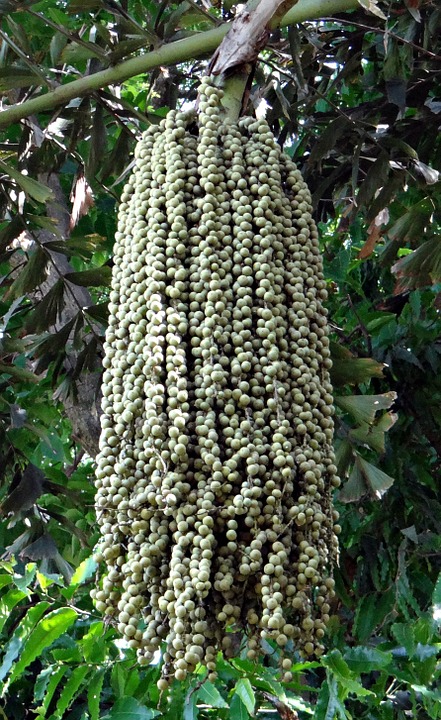A guide to growing fishtail palms

The fishtail palm grows in the rain forest and is native to India, Southeast Asia, and China. This palm gets its name from the leaves because the leaves resemble a fishtail. When first introduced to these palms many years ago I was pretty impressed by their appearance. This plant is pretty unique and is sure to get heads turning. These palms grow well in tropical regions and require the warmth of the sun to perform at their best.
Fishtail palms where among some of the many palms I used on garden projects creating beautiful designs and what I love about this palms is that it is not fussy. The fishtail palm is easy to maintain but when planted outdoors can reach an amazing height. In this article, we will be discussing how to successfully grow these palms both out and indoors.
Things you must know
Planting Location
Fishtail palms love full sun but will thrive in partially shaded areas, these palms reach heights of up, to 25 ft so give them adequate room to grow.
Soil Type
The soil should be soil that has good drainage because fishtails don’t take a liking to wet feet.
Watering Methods
Ensure that the soil is somewhat moist, don’t overwater because this can cause your palm to suffer from root rot.
Fertilizing Methods
Applying a liquid feed fertilizer that is formulated for palms once a month or directed by the label that is on the fertilizer’s bag will keep your fishtail growing healthy and happy.
Garden insect pest of the fishtail palms
- Spider Mites
Spider Mites are a common pest problem if you discover webbing on your plant then further test your findings by taking a white sheet of paper and place it under the leaves, gently tap or shake the leaves, you will see tiny black dots moving around on that sheet of paper you may also feel them crawling on your hands. Using insecticidal soap will bring spider mites under control.
Diseases of the fishtail palms
Be on the lookout for Pseudomonas disease. To know if your fishtail palm is affected by this disease look for signs of lesions that are wet and brown which runs parallel to your fishtail palm leaves. To stop the spread of this disease use a sharp pruner and remove the infected leaves. Sterilize the pruner with bleach and water after use and spray with WD 40 for it to keep its sharpness as well as being lubricated.
Where to install them
Here are a few ideas on how to use the fishtail palm
- Fishtail palms can be used as a stand-alone or specimen plant
- Because these palms grow dense can be used to create privacy
- Can be installed on either side of the main entrance door
- Looks great as a backdrop in a garden design
- Plant fishtail palms along fences
- Install them alongside a garden wall
- What about planting them at the corners of your house
Container grown fishtail palms
When growing fishtail palms from containers ensure that the container is large enough to accommodate your palm at maturity. In my opinion, once your fishtail palm starts to reach maturity it is best to remove them from the container and plant them in their permanent spot. The soil should be well-drained and the container should be placed in an area that gets full to partial sunlight.
The soil should be kept moist and the container should have drain holes to allow excess water to drain through. Fertilize as discussed earlier and keep an eye out for spider mites and treat with insecticidal soap following the direction on the manufacturer’s label.
Growing fishtail palms indoors
There was a project that both my former tame and I undertook many years ago which was installing giant fishtail palms in the hotel’s atrium. These palms were huge but once they were set in place added to the aesthetics of the garden design. There were also other projects that involved smaller fishtail palms that we placed in decorative containers and these containers were placed in different areas of the hotel which give that wow.
The potting soil or growing medium when installing fishtail palms indoors should be well-drained soil, keep the soil moist but not waterlogged ensure that the container has drain holes to allow water to drain and a saucer to collect this water. The container should be placed at a south or west window where your plant can get about 4-5 hours of sunlight
Provide humidity for your fishtail palm by misting the leaves with water or using a room humidifier. Without humidity, the plant’s growth will be affected and the leaves will turn yellow. Fertilize with a fertilizer that is formulated for palms and follow the manufacturer’s label.
The final word
The fishtail palms are pretty amazing. This plant is unique and will bring that much-needed flavor to your garden or interior plantscape area. I have worked with them over the years and have seen first hand what they can do. So give these palms a try as you take your garden and landscape to the next level. Fishtail palms a plant that is worth the investment.
About the author
Norman loves being in the garden, both at home and for his job....
he is 'Natures Little helper' being outdoors, growing his vegetables and flowers from an early age.
Now having spent over 22 years in the profession he want to give some of his knowledge to others...
his vast array of hints and tips you will find scattered over this site will help you no end growing plants in your garden.
